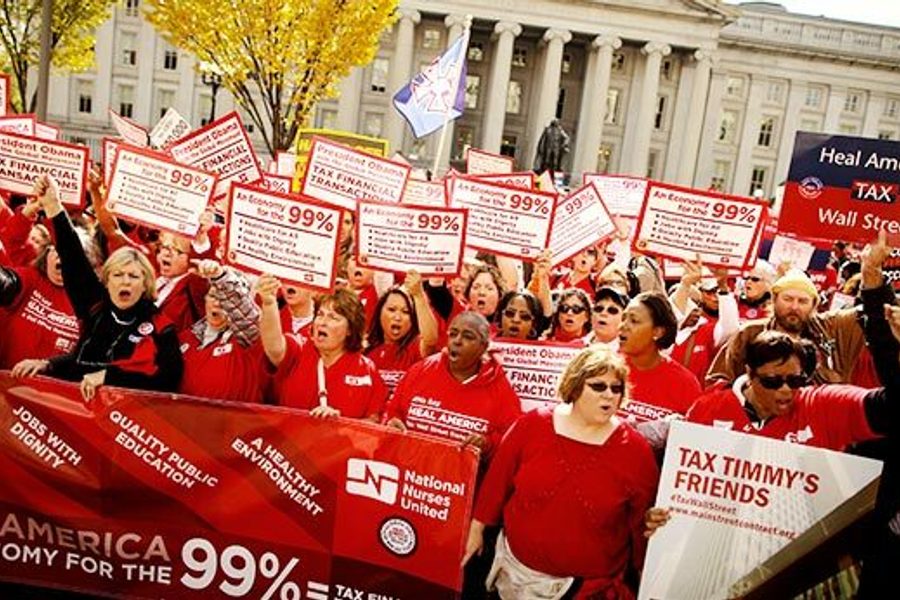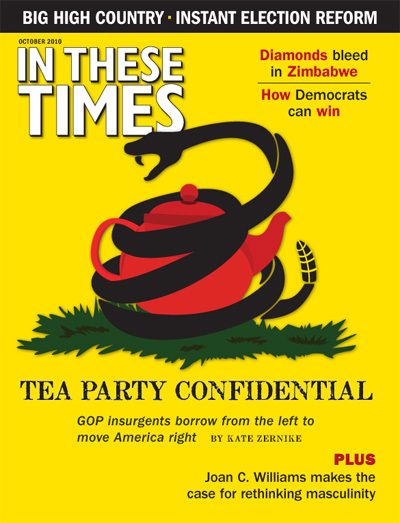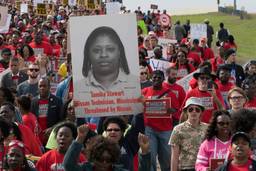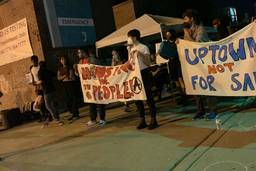Kaiser’s Bitter Labor War
Upstart NUHW challenges SEIU in California hospitals—and the future of healthcare unionism.
David Moberg

Throughout late summer, in most Kaiser Permanente hospitals in California, a battle was playing out over what union about 43,000 workers would elect to represent their interests – making it the biggest National Labor Relations Board balloting since 1941, and a vote that could greatly influence the future of healthcare unionism.
The conflict manifested itself daily in the color of lanyards employees chose for their identification cards. Supporters of the incumbent Service Employees International Union-United Healthcare Workers West (SEIU-UHW) wore purple, while backers of the challenger, National Union of Healthcare Workers (NUHW), wore red. (Workers who did not want to make a public commitment wore Kaiser’s standard-issue blue.)
Former leaders and members of SEIU-UHW formed NUHW in January 2009, immediately after SEIU’s national leaders put the statewide 150,000-member local union in trusteeship. The takeover culminated in a battle between then-SEIU President Andy Stern and local president Sal Rosselli over strategy – and Stern’s decision to shift 65,000 home care workers out of Roselli’s local and into another.
Since then the two unions have fought numerous times over representation of workers: NUHW has won most elections (including three Kaiser units in January), but SEIU has won far more members, since NUHW dropped out of many elections and lost a big, still-contested vote of Fresno home care workers. If SEIU had not successfully delayed elections at Rosselli’s stronghold, Kaiser, NUHW would likely have won early last year. But now both sides, while predicting victory, see the vote as hard to call.
SEIU argues that a switch to NUHW will endanger everything in workers’ existing Kaiser contract, including recently negotiated and approved changes. But it also attacks Rosselli’s leadership as corrupt – overstating the implications of a $1.57 million civil court judgment that the Rosselli team prepared to launch NUHW during its last weeks in office at SEIU.
SEIU executive vice president and SEIU-UHW trustee Dave Regan says, “It’s a situation where a very large number of healthcare workers are going to vote on essentially whether or not to preserve and protect the gains we’ve recently made in national bargaining or literally put all that at risk.”
NUHW says the question is what kind of union workers will have. Will it be a “member-driven” union willing to carry on the fights that won most of what’s in the Kaiser contract, or a centralized union based in Washington and willing to make concession deals with management? According to Rosselli, a majority of Kaiser workers support NUHW because they want “to control their union and their relationship with Kaiser, to stop [SEIU] from further dismantling the best hospital contract in the country.”
Recently removed (at SEIU’s initiative, she says) from a job that permitted her to roam her Oakland hospital, 20-year Kaiser veteran Yolanda Chavez shares Rosselli’s views. “We must get to people and educate them about … the difference between a corporate union, where the union meets with bosses and makes deals behind our back,” she says, “and a union run by us workers, where we have a voice and vote.”
“This isn’t an argument [about ideas]. It’s a reality,” rejoins Regan. “But it’s turned into a preoccupation with Andy Stern’s philosophy, union democracy, God knows what. They’re important, but a distraction. The only way NUHW wins is for every human being to be put at enormous risk, and that’s unacceptable.”
While the law is murky on some fine points about what happens to an existing contract when one union decertifies another, it clearly supports NUHW’s argument more than SEIU’s. Under federal law, the old contract is “null and void” (the incumbent union is no longer a bargaining agent). The employer must bargain with the new union when it is certified. In the meantime, all the “terms and conditions of employment” from the old contract remain in force.
“Going on basic [National Labor Relations] Board law,” says Ellen Dannin, a former attorney for the NLRB and author of Taking Back the Workers’ Law, “the terms of employment remain the status quo until there is an agreement between the successor union and the employer, or if the parties reach impasse, when the employer can impose terms.” The risk, then, is essentially what any union faces at contract time. Two other labor law experts – one employed by a union, the other an academic at the NLRB – concurred with Dannin, but asked not to be named. And the NLRB itself sided with NUHW when it issued a complaint that Kaiser had unlawfully refused to abide by three provisions of the old contract after NUHW won three decertification elections early this year.
NUHW leaders claim SEIU has the advantage of thousands of staff, up to $45 million and support from Kaiser management, while NUHW relies on networks of stewards and workers, volunteers and less than $2 million. Regan says all that’s exaggerated – his union’s budget for the election will be $4 million to $5 million, supplemented by volunteers, with no aid from Kaiser.
Ballots were mailed September 13 and will be counted October 6. Neither side is likely to vanish after the election, but the workers’ decision in this big election will deeply affect the future of both unions and their bitter fight.
David Moberg, a former senior editor of In These Times, was on staff with the magazine from when it began publishing in 1976 until his passing in July 2022. Before joining In These Times, he completed his work for a Ph.D. in anthropology at the University of Chicago and worked for Newsweek. He received fellowships from the John D. and Catherine T. MacArthur Foundation and the Nation Institute for research on the new global economy.









